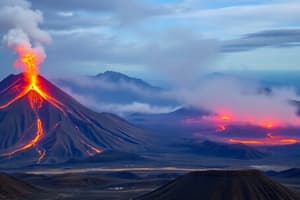Podcast
Questions and Answers
What is the hot, red fluid that comes out of an erupting volcano?
What is the hot, red fluid that comes out of an erupting volcano?
- Pyroclastic material
- Volcanic ash
- Lava (correct)
- Magma
Which type of lava is low in gas content, fluid, and forms wide plateaus?
Which type of lava is low in gas content, fluid, and forms wide plateaus?
- Basaltic lava (correct)
- Rhyolitic lava
- Andesitic lava
- Dacitic lava
What is the molten rock beneath the surface called?
What is the molten rock beneath the surface called?
- Lava
- Volcanic ash
- Pyroclastic material
- Magma (correct)
What is the classification for earthquakes with a focus less than 100 km?
What is the classification for earthquakes with a focus less than 100 km?
Which part of the Earth releases gas followed by pyroclastic material during a volcanic eruption?
Which part of the Earth releases gas followed by pyroclastic material during a volcanic eruption?
Where are shallow focus earthquakes classified?
Where are shallow focus earthquakes classified?
What type of lava is high in gas content, sticky, and forms lava domes?
What type of lava is high in gas content, sticky, and forms lava domes?
What is the softer upper mantle beneath the lithosphere called?
What is the softer upper mantle beneath the lithosphere called?
Where is the Ring of Fire located?
Where is the Ring of Fire located?
What causes earthquakes?
What causes earthquakes?
Flashcards are hidden until you start studying
Study Notes
- The text discusses natural disasters, specifically volcanic eruptions and earthquakes.
- The Earth's crust is alive and moves, leading to volcanic activity and earthquakes.
- Volcanic eruptions release gas, followed by pyroclastic material, including volcanic ash.
- Volcanic ash can reflect sunlight and cause mini ice ages and pose a threat to aircraft.
- Lava is the hot, red fluid that comes out of an erupting volcano.
- Magma is the molten rock beneath the surface, and lava is the same magma when it reaches the surface.
- Basaltic lava is low in gas content, fluid, and forms wide plateaus, while rhyolitic lava is high in gas content, sticky, and forms lava domes.
- Earthquakes release energy in the form of seismic waves, causing the ground to shake.
- Earthquakes are classified by depth, with shallow-focus earthquakes having a focus less than 100 km and deep-focus earthquakes having a focus deeper than 100 km.
- The asthenosphere, the upper mantle beneath the lithosphere, is softer due to high pressure and temperature and forms the basis of plate tectonics.
- There are three types of plate boundaries: transform, divergent, and convergent.
- Volcanic activity and shallow focus earthquakes occur at divergent boundaries.
- The Ring of Fire, where 90% of earthquakes and 75% of volcanic activity occurs, is located along convergent and divergent boundaries.
- The Pacific Plate is an example of an oceanic plate, and the Eurasian Plate is an example of a continental plate.
- The relative motion of plates causes crustal movements and earthquakes and volcanic eruptions at plate boundaries.
- There are three types of plate boundaries: transform, divergent, and convergent.
- Divergent boundaries are characterized by volcanic activity and shallow focus earthquakes.
- 90% of earthquakes and 75% of volcanic activity occur in the Ring of Fire along convergent and divergent boundaries.
Studying That Suits You
Use AI to generate personalized quizzes and flashcards to suit your learning preferences.




